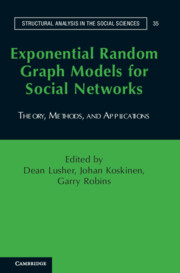Book contents
- Frontmatter
- Contents
- List of Figures
- List of Tables
- 1 Introduction
- Section I Rationale
- Section II Methods
- Section III Applications
- 14 Personal Attitudes, Perceived Attitudes, and Social Structures: A Social Selection Model
- 15 How To Close a Hole: Exploring Alternative Closure Mechanisms in Interorganizational Networks
- 16 Interdependencies between Working Relations: Multivariate ERGMs for Advice and Satisfaction
- 17 Brain, Brawn, or Optimism? Structure and Correlates of Emergent Military Leadership
- 18 Autologistic Actor Attribute Model Analysis of Unemployment: Dual Importance of Who You Know and Where You Live
- 19 Longitudinal Changes in Face-to-Face and Text Message–Mediated Friendship Networks
- Chapter 20 Differential Impact of Directors’ Social and Financial Capital on Corporate Interlock Formation
- 21 Comparing Networks: Structural Correspondence between Behavioral and Recall Networks
- Section IV Future
- References
- Index
- Name Index
17 - Brain, Brawn, or Optimism? Structure and Correlates of Emergent Military Leadership
Published online by Cambridge University Press: 05 April 2013
- Frontmatter
- Contents
- List of Figures
- List of Tables
- 1 Introduction
- Section I Rationale
- Section II Methods
- Section III Applications
- 14 Personal Attitudes, Perceived Attitudes, and Social Structures: A Social Selection Model
- 15 How To Close a Hole: Exploring Alternative Closure Mechanisms in Interorganizational Networks
- 16 Interdependencies between Working Relations: Multivariate ERGMs for Advice and Satisfaction
- 17 Brain, Brawn, or Optimism? Structure and Correlates of Emergent Military Leadership
- 18 Autologistic Actor Attribute Model Analysis of Unemployment: Dual Importance of Who You Know and Where You Live
- 19 Longitudinal Changes in Face-to-Face and Text Message–Mediated Friendship Networks
- Chapter 20 Differential Impact of Directors’ Social and Financial Capital on Corporate Interlock Formation
- 21 Comparing Networks: Structural Correspondence between Behavioral and Recall Networks
- Section IV Future
- References
- Index
- Name Index
Summary
Emergent Leadership in Military Context
Traditional approaches to leadership tend to focus on the characteristics and behaviors of formal, appointed leaders (see Yukl, 2010, for a review of theories). Little is known, however, about the distribution of leadership potential within a group or how informal leadership emerges. With the shift to flattened, self-managed teams, researchers have now begun to explore the emergence of informal leadership (Neubert & Taggar, 2004). Emergent leadership is defined as “the process by which informal leaders emerge in a team, typically in leaderless groups.” Emergent leaders are often “internal champions,” people who exert significant influence over other members of their group although no formal authority has been vested in them (Goktepe & Schneier, 1989).
The study of emergent leadership originates in small group research (e.g., Bales, 1953), where it was often found that in leaderless group discussions, one or two informal leaders emerge. Since then, most of the research on emergent leadership has focused on two main issues. The first is the examination of the antecedents of leadership emergence, in an attempt to predict which individual will eventually emerge as a leader. The second focus is on the structure of emergent leadership. We briefly describe each of these.
- Type
- Chapter
- Information
- Exponential Random Graph Models for Social NetworksTheory, Methods, and Applications, pp. 226 - 236Publisher: Cambridge University PressPrint publication year: 2012
- 3
- Cited by



